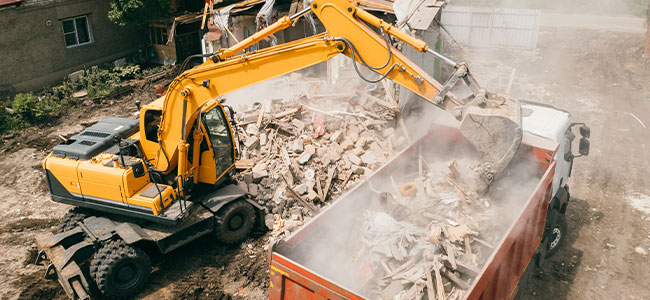
How to Manage Construction Waste Efficiently & Sustainably
To operate more sustainably and responsibly, construction companies must understand the significance of effectively managing construction waste.
- By Erich Lawson
- Feb 29, 2024
What comes to mind when considering construction projects? Towering structures, heavy machinery and bustling activity, right? But amidst all the progress, an often overlooked aspect demands attention: construction waste.
Construction companies are big contributors to the garbage produced due to rapid urbanization and infrastructure development. To operate more sustainably and responsibly, companies must understand the significance of effectively managing construction waste.
Today, we’ll delve into the importance of construction waste management, explain different types of construction waste and explore some practical ways to tackle this pressing issue.
What Is Construction Waste?
Let’s start with the basics. Construction waste is any waste material generated during construction, remodeling, demolition or excavation. Concrete, wood, metals, bricks, glass, polymers and other materials are all part of it.
These materials can burden the ecosystem and threaten human health if not properly handled.
What Are Common Construction Waste Types?
To better comprehend the relevance of construction waste management, one must first become acquainted with the three most common forms of garbage typically created in building projects.
- Inert Waste
Materials that do not undergo substantial physical, chemical or biological changes are classified as inert waste. Inert waste includes dirt, rock, sand and gravel. These items may not represent immediate environmental dangers. However, their effective disposal and reuse are critical for natural resource conservation.
- Non-Hazardous Construction Waste
Another common type of construction waste is non-hazardous waste. It is made up of materials with no inherent hazardous qualities. Wood, concrete, polymers and packaging materials are examples of such trash. Although non-hazardous, their build-up in landfills adds to land resource depletion and increases pollution levels.
- Hazardous Construction Waste
Due to its poisonous, flammable or reactive characteristics, hazardous construction waste poses considerable threats to human health and the environment. Asbestos, lead-based paint, solvents, oils and chemicals are examples of hazardous construction waste.
Proper processing, storage and disposal of waste items are critical for preventing contamination. It’s also essential for the safety of the workers and the surrounding community.
What Role Does Construction Waste Management Play?
So that establishes the significance of waste management in construction. Now let’s look at some of the specific factors that make it non-negotiable.
- Environmental impact. Unmanaged construction waste adds to soil, air and water contamination. It damages natural ecosystems, adversely affects biodiversity and worsens climate change. It’s possible to reduce the ecological impact of construction waste and contribute to a cleaner, healthier environment by employing efficient waste management practices.
- Conservation of natural resources. Construction projects deplete large amounts of natural resources. Lessen the requirement for collecting and processing raw materials by managing construction waste. Recycling, reusing and repurposing are all ways to save resources. They also cut energy consumption and greenhouse gas emissions from producing new materials.
- Legal compliance. Many nations have strict construction waste management legislation and standards. Following these standards helps avoid legal penalties, reputational harm and costly lawsuits. So stay current on local waste management rules and include them in project design and implementation.
How Do Companies Manage Construction Waste?
To shift from unmanaged trash disposal to meticulous waste management, check out these five practical tips that can be super useful.
- Waste Management Plan Implementation
It's critical to create a detailed waste management strategy for each project. This strategy should include trash reduction, sorting, recycling and disposal techniques. To efficiently implement this construction waste management plan at every step, include all stakeholders, create clear goals and provide enough resources.
- Recycling
Recycling is an important component of long-term waste management. Separation and recycling of concrete, metals, wood and plastics should be prioritized. Thus, educating employees on the correct recycling practices of construction waste is non-negotiable.
Placing enough recycling bins on the work site and deploying a commercial trash compactor can greatly help to minimize the quantity of garbage transported to landfills.
- Reduce Packaging
Construction supplies are sometimes packaged excessively, resulting in colossal waste creation. Take it as a responsibility to work with suppliers to reduce packing materials and adopt environmentally friendly alternatives. Construction businesses may drastically minimize waste on-site by choosing bulk delivery and reusable packaging.
- Reuse Waste
Instead of throwing building waste, companies should look into repurposing it. Reusing resources such as wood, bricks and metals not only saves money but also lowers demand for new materials. Instilling a culture of resourcefulness and ingenuity among the construction crew can lead to novel approaches to waste management in construction.
- Stringent Administration
A well-organized construction site is essential for efficient trash management. But what does an adequately administered site look like? An administration can reduce material loss, avoid cross-contamination and speed up waste disposal. Systems such as labeling and segregation are in place at a well-managed construction site.
Also, regular site inspections and training programs guarantee employees follow waste management guidelines on an ideal construction site.
Construction waste management is an urgent issue that requires prompt action. So, companies should get ready to boost sustainability by applying appropriate waste management practices.
About the Author
Erich Lawson is the Online Marketing Manager of Compactor Management Company. He is very passionate about the environment and is an advocate of effective recycling. He writes on a wide array of topics to inform readers on how modern recycling equipment can be used by industries to reduce monthly wastage bills and increase recycling revenue. You can learn more about environment saving techniques by visiting his blog at norcalcompactors.net.